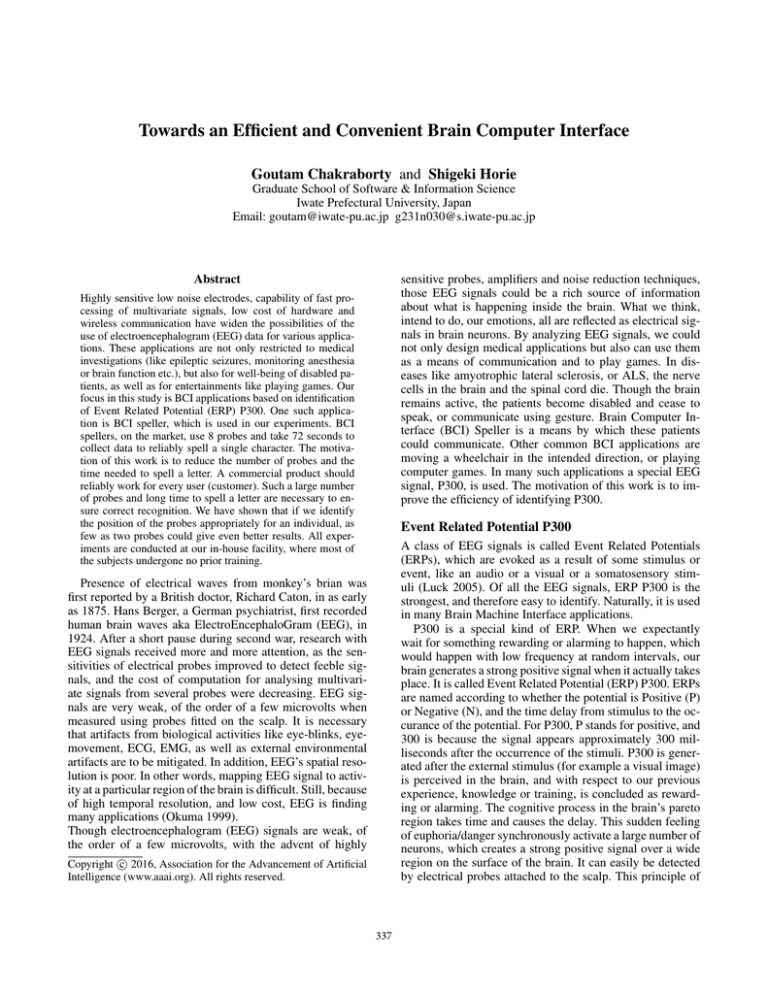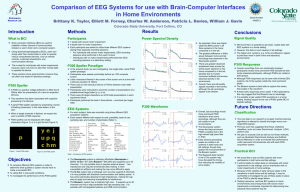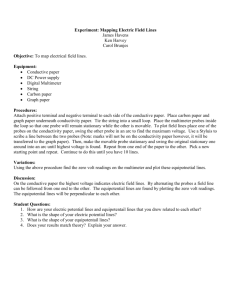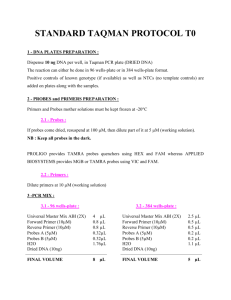
Towards an Efficient and Convenient Brain Computer Interface
Goutam Chakraborty and Shigeki Horie
Graduate School of Software & Information Science
Iwate Prefectural University, Japan
Email: goutam@iwate-pu.ac.jp g231n030@s.iwate-pu.ac.jp
sensitive probes, amplifiers and noise reduction techniques,
those EEG signals could be a rich source of information
about what is happening inside the brain. What we think,
intend to do, our emotions, all are reflected as electrical signals in brain neurons. By analyzing EEG signals, we could
not only design medical applications but also can use them
as a means of communication and to play games. In diseases like amyotrophic lateral sclerosis, or ALS, the nerve
cells in the brain and the spinal cord die. Though the brain
remains active, the patients become disabled and cease to
speak, or communicate using gesture. Brain Computer Interface (BCI) Speller is a means by which these patients
could communicate. Other common BCI applications are
moving a wheelchair in the intended direction, or playing
computer games. In many such applications a special EEG
signal, P300, is used. The motivation of this work is to improve the efficiency of identifying P300.
Abstract
Highly sensitive low noise electrodes, capability of fast processing of multivariate signals, low cost of hardware and
wireless communication have widen the possibilities of the
use of electroencephalogram (EEG) data for various applications. These applications are not only restricted to medical
investigations (like epileptic seizures, monitoring anesthesia
or brain function etc.), but also for well-being of disabled patients, as well as for entertainments like playing games. Our
focus in this study is BCI applications based on identification
of Event Related Potential (ERP) P300. One such application is BCI speller, which is used in our experiments. BCI
spellers, on the market, use 8 probes and take 72 seconds to
collect data to reliably spell a single character. The motivation of this work is to reduce the number of probes and the
time needed to spell a letter. A commercial product should
reliably work for every user (customer). Such a large number
of probes and long time to spell a letter are necessary to ensure correct recognition. We have shown that if we identify
the position of the probes appropriately for an individual, as
few as two probes could give even better results. All experiments are conducted at our in-house facility, where most of
the subjects undergone no prior training.
Event Related Potential P300
A class of EEG signals is called Event Related Potentials
(ERPs), which are evoked as a result of some stimulus or
event, like an audio or a visual or a somatosensory stimuli (Luck 2005). Of all the EEG signals, ERP P300 is the
strongest, and therefore easy to identify. Naturally, it is used
in many Brain Machine Interface applications.
P300 is a special kind of ERP. When we expectantly
wait for something rewarding or alarming to happen, which
would happen with low frequency at random intervals, our
brain generates a strong positive signal when it actually takes
place. It is called Event Related Potential (ERP) P300. ERPs
are named according to whether the potential is Positive (P)
or Negative (N), and the time delay from stimulus to the occurance of the potential. For P300, P stands for positive, and
300 is because the signal appears approximately 300 milliseconds after the occurrence of the stimuli. P300 is generated after the external stimulus (for example a visual image)
is perceived in the brain, and with respect to our previous
experience, knowledge or training, is concluded as rewarding or alarming. The cognitive process in the brain’s pareto
region takes time and causes the delay. This sudden feeling
of euphoria/danger synchronously activate a large number of
neurons, which creates a strong positive signal over a wide
region on the surface of the brain. It can easily be detected
by electrical probes attached to the scalp. This principle of
Presence of electrical waves from monkey’s brian was
first reported by a British doctor, Richard Caton, in as early
as 1875. Hans Berger, a German psychiatrist, first recorded
human brain waves aka ElectroEncephaloGram (EEG), in
1924. After a short pause during second war, research with
EEG signals received more and more attention, as the sensitivities of electrical probes improved to detect feeble signals, and the cost of computation for analysing multivariate signals from several probes were decreasing. EEG signals are very weak, of the order of a few microvolts when
measured using probes fitted on the scalp. It is necessary
that artifacts from biological activities like eye-blinks, eyemovement, ECG, EMG, as well as external environmental
artifacts are to be mitigated. In addition, EEG’s spatial resolution is poor. In other words, mapping EEG signal to activity at a particular region of the brain is difficult. Still, because
of high temporal resolution, and low cost, EEG is finding
many applications (Okuma 1999).
Though electroencephalogram (EEG) signals are weak, of
the order of a few microvolts, with the advent of highly
c 2016, Association for the Advancement of Artificial
Copyright Intelligence (www.aaai.org). All rights reserved.
337
interface, by identifying P300, is used to design many BCI
applications.
Motivation of this Work
Helping communication for ALS or spinal cord injured patients by using BCI is one important area of research and
development. Its working principle is simple. The subject
chooses letters in sequence, one at a time, from the word
he intends to spell. Different characters flash on the display
at random intervals. When the chosen letter flashes, the subject’s brain is stimulated to generate ERP300 signal, because
identifying it is like a reward to her. The signal is strong as
it happens occasionally, at random intervals, and the subject has to concentrate so that he does not miss it. Due to
external noise, spurious noise from brain and other instabilities, due to individual’s variations, for identifying ERP300
signal multiple probes are used at different positions on the
scalp. The robustness of the system is improved when multivariate signals are analyzed together. In addition, for a sigle
letter, the experiment is repeated several times to reduce
the probability of misclassification. Commercially available
BCI speller (EGI 2010) used 8 probes, and takes 72 seconds
to read a single character. The motivation of this work is to
reduce the number of probes and the time to spell a letter.
Figure 1: P300 BCI Speller Display
to classify those 120 signals into two groups, with P300 and
without P300. Subjects concentrate, not to miss a target flash
for which the probability is low (20/120 = 1/6). If the probability is made lower, P300 signal will be stronger, but at the
cost of longer time needed to communicate a character. The
strongest P300 signal does appear near central and parietal
region of the brain. But the location for strongest signals
vary from person to person. Eight probes, spread over central and pareto region of the brain, are used for commercial
products, This is to ensure that the machine works for everyone.
In this work, we will show that if we design BCI speller
for individual use, we can reduce the number of probes.
An ALS patient, who needs such communication tool, it is
worth to find proper probe location/s. We can then reduce
the cost of the equipment, do the processing efficiently, as
well as increase the spelling accuracy.
In our experiment, we collected EEG signals from many
probes, group them into clusters, and select one representative probe from each cluster. A fewer selected probes, for all
subjects, gave better recognition results. The results are stable over a time, i.e. the probe locations do not change when
experiments performed are stretched over one year. In our
previous work, we arbitrarily fixed the number of probes to
4 (Yokoha, Chakraborty, and Kikuchi 2014). In this report,
we will show that further reduction is possible by running
multi-objective combinatorial optimization algorithm to select relevant probes. In fact, better classification results were
obtained with even fewer than four probes. The results are
compared with our previous work (Yokoha, Chakraborty,
and Kikuchi 2014) and another work (Hoffmann and et.al.
2008).
Organization of the Manuscript
The paper is organized as follows. Following introduction,
in section 2, we will explain the working principle of BCI
speller. In section 3, we describe the experimental set-up and
its details. In section 4, our approach to reduce the number of
probes is explained. Section 5 includes experimental results
and comparisons with previous works. Finally, we conclude
the paper in section 6, indicating future works.
Working Principle of BCI Speller
In this work we will focus on BCI speller, though the idea of
efficient identification of P300 could be extended to other
applications. The basic principle of the working of BCI
speller is as follows. In P300 BCI Speller, the display consists of a matrix of English alphabets and numerals. These
26 characters and 10 numerals are arranged in a 6 × 6 matrix form, as shown in Fig. 1. As the spelling task begins, a
particular row or column flash at a time. To communicate a
single character or numeral, all the six rows and six columns
flash for 10 times. The flashing occurs with random uniform
probability distribution. The duration of the flash is 600 ms.
Thus, the time required to communicate a single target character/numeral is (6 + 6) × 10 × 600ms. = 72 Sec. Every
time the character to be communicated is included in the row
or column which is flashed, the subject is to count up. The
subject needs to concentrate, so as not to miss the flash of
the intended character, which happens at irregular intervals.
The success of the detection creates a strong ERP P300, or
in short P300, which is detected by the probes attached on
the scalp. To read one character, we get 20 signals with ERP
and 100 without. Once those 20 flashing rows/columns with
P300 are identified, the intended character is known, as the
one at the cross point of the row and the column. We need
Experimental Set-up
In conventional BCI speller (EGI 2010), 8 probes on the central and pareto region of the brain are used. Their positions
are F z, Cz, P z, Oz, P 7, P 3, P 4, P 8, as shown in Fig. 2.
Here, F, C, P, O, z stand for Frontal, Central, Parietal, Occipital, and z for the central line dividing the head into left
hemisphere and right hemisphere. Left hemisphere probes
are numbered odd, and the right are numbered even. P 7, P 3
are on the left hemisphere and P 4, P 8 are on the right hemisphere. Our motivation is to find the location of the strongest
338
Figure 2: Position of 8 probes in BCI Speller
P300 signal. Basically, we would like to widen our search
area over the whole surface of the brain. We used 128 probes
Net Station System 300 for dense array EEG from Electrical
Geodesics Inc., to collect EEG signals. It is equipped with
128 probes. The specified noise level is 0.7 μV RMS. A/D
conversion resolution is 24 bit. Maximum sampling rate is
2000 Hz. Input impedance is 200 MΩ. In our experiments,
we used a sampling rate of 1000 Hz.
The user interface is the same as used in conventional BCI
speller, as shown in Fig. 1. Data were collected from healthy
young subjects (students of age around 22). The experimental set-up is explained below. Our aim is to classify EEG signals in to two classes, to identify whether the signal contains
ERP300 or not (Luck 2005).
Our equipment provides 128 probes as shown in Fig. 3. As
analyzing 128 multivariate signals is computationally heavy,
and as we want to cover the whole area of the head, we
selected 21 probes whose locations are evenly spaced, and
recommended by the International 10-20 system (Okuma
1999). It is shown in Fig 4. The space resolution of our data
is thereby reduced.
The subjects are provided with the word to spell, so that
we get a labeled set of supervised samples necessary to train
a classifier.
Figure 3: Probe locations in Net Station System 300
Figure 4: Electrodes from which EEG data were collected.
Preprocessing of the EEG data
Proposed Algorithm
EEG data contains high frequency noise from the environment. By using band-pass filter with a frequency band of
0.1 Hz. to 13 Hz., we clean the high frequency and DC noise.
The upper band is set at 13 Hz, which includes the slow rising P300 as well as α, θ and δ waves. To eliminate spurious
signals, the data is smoothed using moving average, and finally 10 signals collected at a probe while a particular row
or column is flashed, are averaged. Thus, from every probe,
for a particular letter, we get 12 data of which 2 contains
P300. This is a standard procedure to filter out short spurious pulses due to random brain activities. Other artifacts,
As a subject spells a letter, we collect 10 EEG signals corresponding to each row and column, corresponding to 10
flashes. In total we get 120 EEG signals from 21 probes,
each of length 600 miliseconds. 20 such signals, collected
while the target letter is included in the row or column, are
labelled as containing P300. The rest 100 are signals without P300. We analyzed individual subject’s data separately.
Data collected from a single subject is separated into train
and test data. Finally, a 5-fold validation is done to show the
accuracy of the algorithm.
339
Figure 5: Dendrogram of Clustering result
Figure 6: Quite different Signals are grouped in one cluster,
when the number of clusters is low
due to facial muscle movement and eye blinking are cleaned
by embeded software came with the system. In the next step,
for clustering the data collected from different probes, we
used Euclidean distances. For effective clustering based on
the signal shape, we need to normalize the signals. For normalization, used linear pulse code modulation (LPCM), with
8 levels (Goodall 1947). At the time of feature extraction for
classification, signals before normalization is used, because
strength of the P300 signal is used as a feature.
Distance Metric Between Signals and Clustering of
Signals from Different Probes
After normalizing, signals from 21 channels are clustered.
The time delay from stimulus to occurance of P300 varies
a little over the different regions of the scalp. The motivation of clustering is to put signals of similar shape in
one group. In our previous work (Yokoha, Chakraborty, and
Kikuchi 2014), Euclidean distances between signals were
used for clustering. Here, distances between pre-processed
normalized signals are calculated using dynamic time warping (DTW) algorithm. This ensures that signals of similar
shape, though with certain time delay, will have low distance
and would be clustered in the same group.
Using DTW distances, signals are clustered by Ward’s algorithm (Ward 1963), a top-down agglomerative algorithm.
The purpose of choosing top-down algorithm is that, we can
set a threshold for the inter cluster distances and thus tune
the number of clusters visually, using dendrogram. In Fig. 5
it is shown how the number of clusters could be chosen as
2 or 3 or 4, by adjusting the inter-cluster distances. In our
experiments, we used 8 clusters. From each cluster a single probe with strongest P300 signal is selected. Number of
clusters is set to 8 because: (1) we visually checked that then
the members of each cluster have similar shapes. With lower
number of clusters, like 4, even quite different signals are
clubbed together, as shown in Fig.6. A typical signal cluster, when 21 signals are divided in to 8 clusters, is shown
in Fig. 7. (2) Finally, we need to select the optimum set of
probes. If the number of clusters is too high, searching for
the optimum set will be a complex combinatorial problem.
Figure 7: Member signals of a typical cluster group, when
signals from 21 probes are divided into 8 clusters.
Selection of a Representative from each Cluster
Next, we need to select a representative from each cluster.
We select the one for which the change in potential is highest. This is explained in Fig. 8. There are 3 members in the
cluster. We measure the largest difference of potential for
each member of the cluster. That is the score for an individual member. The member with highest score is selected as
the representative of the group.
Multiobjective Optimization for Probe Selection
Our aim is to select minimum number of probes that would
give the highest classification accuracy. After selecting representatives from each cluster, we have 8 EEG signals from
8 clusters. We need to find the minimum subset of these 8probes which would give highest classification result. This
is a multiobjective optimization problem. Though the search
space is small, only 28 − 1, we will use MultiObjective Genetic Algorithm (MOGA). Here, the fitnesses of two objectives are summed (after proper normalization) to calculate
overall fitness. We will compare the results with exhaustive
340
is the fittest sample and will be ranked 1. We normalize the
two criteria for equal weightage.
In the next section, we will compare the results of classification with our previous work reported in (Yokoha,
Chakraborty, and Kikuchi 2014) and with Hoffman et.al.
(Hoffmann and et.al. 2008). In (Yokoha, Chakraborty, and
Kikuchi 2014) the number of probes were fixed to 4. In
(Hoffman 2008) the number of probes were 4, 8, 16 and 32.
We will compare results with 4 probes, as in our experiments
we always had less than 4 probes. Finally, we will compare
results with exhaustive search, and show that though with
some subjects we could achieve very good results even with
only 2 probes, that is not true with all subjects. From the
results, it is evident that training for subjects to concentrate
during experiment is an important prerequisite for successful classification with less number of probes.
Difference with Our Previous Work (Yokoha,
Chakraborty, and Kikuchi 2014)
We compared results with our previous work reported in
(Yokoha, Chakraborty, and Kikuchi 2014). The difference
with the present work is as follows. In(Yokoha, Chakraborty,
and Kikuchi 2014), Euclidean distances were used to calculate distance between signals, not DTW. In addition, the
number of clusters was fixed to 4. Always, 4 probes one
from each cluster were used for identification of P300. In
the present work, we used 8 clusters, but selected the best
subset from 8 probes, eight representatives one from each
cluster.
Figure 8: Cluster representative selection and signal feature
extraction
search to investigate the effectiveness of MOGA. In our future work, we would like to expand the search space when
exhaustive search will be too complex to finish searching in
a reasonable time.
The problem is easy to code in GA. Chromosomes with
8 binary units are used. A gene with 1 represents that that
probe is selected, whereas a 0 represents it is not. 2-point
crossover is used, with crossover probability 0.5. Mutation
is used with 0.01 probability. Tournament selection is used.
Experimental Results and Comparison with
Previous Works
We will compare our results with (Yokoha, Chakraborty, and
Kikuchi 2014) and (Hoffmann and et.al. 2008). The same
data set collected during our experiments was used. We also
compare results with exhaustive search.
Parameters used in PatetoGA experiments.
Feature Selection, Classification and Chromosome
Fitness Calculation
First, features from the selected signals, as described by the
chromosome’s genes, are extracted. From every signal we
extract 2 features, the maximum difference of the potential
and the difference of time for their occurrences. As shown
in Fig 8, the signal with highest (max − min) is selected.
Suppose, the maximum has occured at time tmax and the
minimum at tmin . Then the two features are (max − min),
and (tmax − tmin ).
We have a set of labelled data from a subject, containing signals with and without P300. Now, every data has 2
features and 2 classes. An artificial neural network, trained
using error back propagation, is used for the classifier.
Suppose a chromosome has three 1s and 5 zeros. In that
case, six features are extracted from the three signals, for all
the samples containing ERP300 and not containing ERP300.
The samples are labeled. The classification error is one criterion of a chromosome’s fitness. The other criterion is number of signals, which in this case is 3. Using these two criteria, rankings of all the chromosomes in the population are
calculated according to multi-objective optimization algorithm. We use summation of the two criteria, the minimum
• Population size : 20
• Length of the chromosome : 8(same as the number of
clusters)
• Number of generations : 200
• Crossover: One point crossover with 0.5 crossover probability.
• Selection rule : Tournament selection
In the following table we compare the results of classification for data obtained from 6 subjects. The comparison
is between present work, the work presented in (Yokoha,
Chakraborty, and Kikuchi 2014) and with exhaustive search.
We show the number of probes used and corresponding classification results.
Conclusion and Future Work
In this work, we showed that when relevant probes are selected for an individual, we can reduce the number of probes
to as low as 2, yet achieve improved recognition. The location of probes will be different for different individual.
Our algorithm consists of 2 important steps, clustering and
341
Table 1: Experimental Results
Subject1
Subject2
Subject3
Subject4
Subject5
Subject6
3
72%
3
65%
3
74%
2
71%
2
60%
2
65%
4
59%
4
66%
4
75%
4
64%
4
49%
4
69%
4
57%
4
61%
4
69%
4
61%
4
48%
4
60%
5
73%
4
66%
3
75%
4
77%
3
63%
6
74%
Present work
#probes
Recognition rate
Results using (Yokoha, Chakraborty, and Kikuchi 2014)
#probes
Recognition rate
Results using (Hoffmann and et.al. 2008)
#probes
Recognition rate
Exhaustive search from 8 channels
#probes
Recognition rate
References
selecting a member from each cluster, and finding the optimum combination of signals for highest recognition. We
could achieve better recognition with fewer probes, with every subject.
We learnt that the recognition rate varies from subject to
subject. As we follow results for all subjects, we conclude
that recognition rate is high for a subject who participated in
the experiment many times. Thus training is required to increase concentration during experiment, resulting in higher
recognition rate. For persons whose only way to communication is BCI, would concentrate more. We can expect better
results with such patients.
The whole idea is based on the fact that for an individual, the best probe locations, once found, will not change
with time. At least with 2 subjects, we collected data over a
period of more than a year and found that the locations are
stable. Further research is necessary to decisively make this
conclusion.
As the clustering algorithm is fast, in our next attempt we
will use signals from all the 128 probes available. We hope,
by identifying probe locations more accurately, we could get
better classification result with even less number of probes.
At present, we are experimenting on reducing the time
required to spell a character. There are several works with
this motivation. They are divided into two categories, using
rapid serial visual presentation (Acqualagna and Blankertz
Nov 2011), and based on steady-state visual evoked potentials(Friman et al. 2007) (Nakanishi and et. al. 2014). Our
approach is based on Steady-state visual evoked potentials
(SSVEP) too. We use conventional BCI speller display, but
flash two columns simultaneously with 2 colors and different
frequencies. Similarly, two rows are flashed simultaneously.
Combining the SSVEP signal with P300, we can improve
both the speed of spelling as well as accuracy.
In future, we plan to use all probes, where search space
will expand.
Acqualagna, L., and Blankertz, B. Nov, 2011. A gaze independent spelling based on rapid serial visual presentation.
Annual International Conference of the IEEE Engineering
in Medicine and Biology Society 7.
2010. Electrical geodesics incorporated.
Friman, O.; Luth, T.; Volosyak, I.; and Graser, A. 2007.
Spelling with steady-state visual evoked potentials. In Proceedings of the Annual International conference on Engineering in Medicine and Biology Society.
Goodall, W. M. 1947. Telephony by pulse code modulation.
The Bell System Technical Journal 26:395–409.
Hoffmann, U., and et.al.
2008.
An efficient P300based brain-computer interface for disabled subjects, volume 167(1).
Luck, S. 2005. An Introduction to the Event-Related Potential Technique. MIT Press.
Nakanishi, M., and et. al. 2014. A high-speed brain speller
using steady-state visual evoked potentials. International
Journal of Neural System.
Okuma, T. 1999. Clinical and EEG studies (in Japanese).
Igakushoindai.
Ward, J. H. 1963. Hierarchical grouping to optimize an
objective function. Journal of the American Statistical Association 58:236–244.
Yokoha, H.; Chakraborty, G.; and Kikuchi, D. 2014. Clustering of eeg signal to optimize number of electrodes in bci
applications. In Huang, Y.-P., ed., Proceedings of the International Conference on Complex Medical Engineering
(ICME).
Acknowledgements
Part of this research was supported by research grant from
i-MoS center of Iwate Prefectural University.
342






